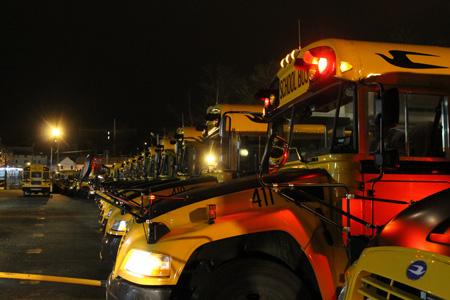February 2, 2012

School buses are lined up before the start of the school day on Tuesday at the Freeport Street bus yard in Dorchester, which is the largest of four bus depots in the city of Boston. Photo by Pat Tarantino
While route and policy improvements have helped Boston Public School administrators tackle the problem of chronically late school buses that plagued the first month of the school year, drivers say some routing problems continue to hinder their on-time performance.
The 2011-2012 school year marked the first time BPS relied on Versitrans, a computerized routing system, to dictate bus routes. But the innovation was a disaster in the first weeks of the academic year, as nearly 40 percent of all students arrived after the school day had begun. Although the number of late students has now dropped to less than 10 percent, questions of responsibility for the year’s poor start mean BPS may not be able to recover around $800,000 in fines levied against its transportation subcontractor, First Student. The company, which has been contracted to run the city’s bus system since 2003, claims that it shouldn’t have to pay the fines because the city —not the company— devised the routes.
According to BPS spokesperson Matthew Wilder, the $800,000 in fines cover the first three months of the school year and were sent to First Student earlier this month. While Wilder said individual fines against the company could be waived if the claim “falls outside of the provisions we have set out” for service, he said the routing software was not the sole cause for late buses.
“What we’ve found in the midst of our crisis - and we will call it a crisis - is that one of the major problems was that there was a lack of leadership at the bus yards,” Wilder told the Reporter this week. “We sent employees to monitor the bus yards and in some instances bus drivers were arriving and leaving late.
“For anyone to put all the fault on the routing software is just a ploy to say our use of computers is not the way to go. We think differently,” said Wilder.
One of those school employees, Kim Rice, spent every morning at the Glover’s Corner bus yard during the height of the bussing issue in October and November. Rice was tasked with ensuring that the 187 school buses - each of which is responsible for three hour-long pickup routes every morning - left the yard on time. Since then, Rice said departure times have become much more uniform and the system now only sends employees to perform periodic spot checks at the city’s four bus yards.
The Freeport Street yard— which is privately owned and leased to First Student— is home to 220 buses, making it the largest of the city’s four permanent bus yards. Fourteen percent of all routes are run by stand-by buses that are employed in the case of equipment trouble or route delays.
First Student area general manager Bob Timility said that the presence of BPS staff on-site played a major role in improving performance.
“They’re getting much better at pushing the drivers out on time and changing the routes when there are problems,” Timilty said. “They’re constantly changing routes whenever the school department finds a problem.”
Although Wilder and others say much of the blame falls on First Student-managed bus yards that failed to send drivers out on time, School Bus Drivers Union Local 8751 steward Dumond Louis said computer-generated routes created confusion among many drivers by listing both a student’s home address and their pick-up point.
According to Louis, a route schedule could have a driver picking up students living on each side of a two-way street with zero minutes travel time between pick up points. Looking at only the home addresses, Louis said many drivers would take a lengthy detour around a block in order to park on the opposite side of a street and thus back up an entire busload of students.
“They want to save every penny using software to make the routes,” Louis said. “But for a city like Boston, that’s nearly impossible. Traffic doesn’t work like it does in the suburbs.”
Since these problems came to light, BPS began incorporating human route planners back into the planning process in order to ensure pick-up schedules were feasible for drivers. Wilder said that rather than receiving calls about the same problematic routes on a daily basis, late buses now tend to stem from stalled traffic or break downs along different routes, indicating that the systemic causes for late buses have been addressed.
“The most important thing for us is for parents to know that we have been just as frustrated if not more so than them through this process and we think the level of service provided has been unacceptable,” Wilder said.
“But the numbers indicate that we have made really great improvements. That being said, we still have one out of ten students showing up late - a minute late is just as bad as 30 minutes to us. It’s unacceptable.”


